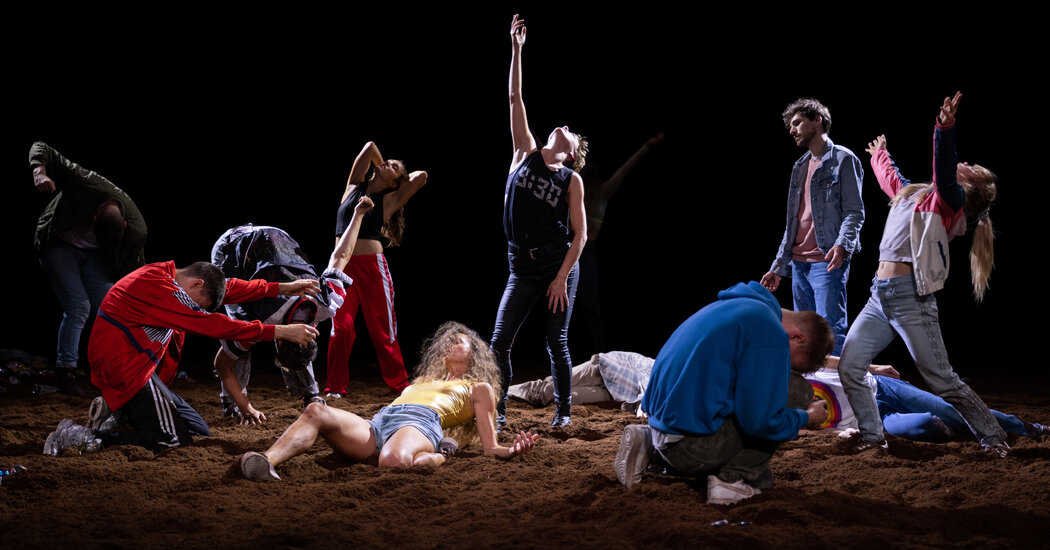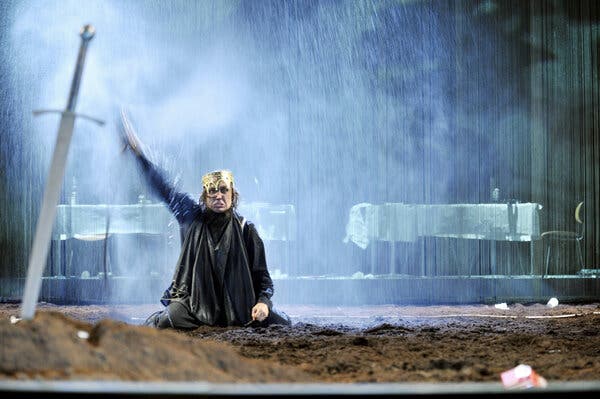
Balenciaga’s spring 2023 show, which took place this October at a darkened convention center on the outskirts of Paris, was a complete mess. To match the collection’s aggressive, almost militaristic severity — a multipocket combat jacket, graffitied hoodies, a dress made entirely from the brand’s repurposed leather City bags — the Spanish artist Santiago Sierra hauled over 9,700 cubic feet of dank earth into the venue to create troughs through which models plodded, their clothes gathering sludge with each step. A custom scent, redolent of decomposition and developed by the Norwegian smell researcher and artist Sissel Tolaas, lingered in the post-apocalyptic bog. According to Balenciaga’s artistic director, Demna, the set was “a metaphor for digging for truth.”
In recent years, particularly after the arrival of the novel coronavirus and the ensuing travel restrictions, it was sand that emerged as the perfect escapist symbol: a shorthand for a vacation destination where we could all bury our heads for a bit. Most memorable was Lina Lapelytė’s opera “Sun & Sea,” which toured globally during the pandemic after winning a top prize at the 2019 Venice Biennale and featured beachgoers who performed Vaiva Grainytė’s libretto about the climate crisis. While the Earth warms, they just keep on relaxing.

The German actor Lars Eidinger in Thomas Ostermeier’s 2022 production of “Hamlet” at the Brooklyn Academy of Music.Credit…Photo by Arno Declair, courtesy of BAM
But if sand is a Beckettian distraction, the Balenciaga show reflected the storm brewing in our own backyard. “With dirt and mud, you’re trying to bring a certain kind of reality back into the white cube realm of grand bourgeoisie,” says the 54-year-old German experimental theater director Thomas Ostermeier. “You’re creating tension between sterile spaces and this very sensual material.” In his savage reinterpretation of William Shakespeare’s “Hamlet,” which made its American debut earlier this fall as part of the Brooklyn Academy of Music’s Next Wave Festival, the Danish royal family spirals into madness on a burial site designed by Ostermeier’s German collaborator Jan Pappelbaum with an acre of mud. As the story unfolds and the characters unravel, wet soil comes to represent their decaying mental state: The actors rub it on their faces and stuff it into one another’s mouths. “The more the world goes down, the more Shakespeare becomes relevant,” Ostermeier says.
In the French Austrian choreographer Gisèle Vienne’s “Crowd,” which also had a run at BAM in October, a troupe of dancers writhe to techno music on a dirt-covered stage. As its name suggests, the performance takes place at a packed rave where revelers use their bodies to convey feelings of isolation and ecstasy in a story written by Vienne and the American author Dennis Cooper. As the performers lose themselves in E.D.M. tracks from the ’90s, grinding on one another and across the grimy floor, the audience, too, feels as if they’ve stepped into a party at the end of the world — though the image that lingers is not of the rager itself but the wasteland left in its wake.
Similarly, for her contribution to this year’s Venice Biennale, “Earthly Paradise,” Delcy Morelos created hedges of soil that surround the viewer’s body like the walls of a labyrinth — a quietly unnerving immersion in what she has called the “intimate humidity of the earth.” The Colombian artist, who will mount her next installation at Dia Chelsea in fall 2023, seemed to be engaging with the legacy of “The New York Earth Room” (1977) by the American artist Walter De Maria, itself made from about 280,000 pounds of dirt, and a rumination on our complicated relationship with nature (the piece is still maintained in SoHo by Dia Art Foundation). Of course, as an analogy for our present moment — or our “empire of dirt,” to quote the Nine Inch Nails frontman, Trent Reznor — mud isn’t subtle: The world is in a state of decrepitude. Even the way we talk about things — dirty money, internet trolls — is sullied. The clearest way out of the muck, these artists and creators seem to be saying, isn’t to button up and double down on the hallmarks of civilized prosperity but to return to nature, embracing collective catharsis and the occasional anarchic release. If they’re to be believed, we must adhere to a sort of sociological composting — of breaking things down so that they might grow back stronger, of getting into the mud together, if only to enjoy the cleansing that comes after. As Ostermeier sees it, his stage isn’t just a graveyard: “It’s also a playground.”